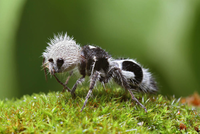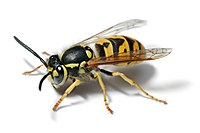
The odorant receptor co-receptor gene contributes to mating and host searching behaviors in parasitoid wasps.
Sign Up to like & getrecommendations! Published in 2022 at "Pest management science"
DOI: 10.1002/ps.7214
Abstract: BACKGROUND Biological control of pest insects by parasitoid wasps is an effective and environmentally friendly strategy comparing to synthetic pesticides. Successful courtship and host search of parasitoid wasps are important to the biological control efficiency… read more here.
Keywords: wasps; receptor; host searching; parasitoid wasps ... See more keywords

Context-dependent use of olfactory cues by foragers of Vespula germanica social wasps.
Sign Up to like & getrecommendations! Published in 2021 at "Animal cognition"
DOI: 10.1007/s10071-021-01583-4
Abstract: Food search is guided by cues from different sensory modalities, such as olfactory and visual. In social wasps, olfaction plays a key role in locating new resources. However, while several studies have focused on the… read more here.
Keywords: response; use; wasps; vespula germanica ... See more keywords

Spiders mimic the acoustic signalling of mutillid wasps to avoid predation: startle signalling or Batesian mimicry?
Sign Up to like & getrecommendations! Published in 2020 at "Animal Behaviour"
DOI: 10.1016/j.anbehav.2020.10.015
Abstract: The importance of vision-reliant defensive traits (e.g. warning colours) in mimicry studies is well established, but their effectiveness is limited by visibility. In low light conditions, for instance, acoustic or tactile channels may be more… read more here.
Keywords: mutillid wasps; stridulation; wasps; spiders mimic ... See more keywords

Spatial memory in Vespula germanica wasps: A pilot study using a Y-maze assay
Sign Up to like & getrecommendations! Published in 2021 at "Behavioural Processes"
DOI: 10.1016/j.beproc.2021.104439
Abstract: In the present study we analysed spatial learning in Vespula germanica wasps when dealing with a walking Y-maze. We recorded the time taken to leave the maze during two consecutive visits and which of the… read more here.
Keywords: spatial memory; vespula germanica; wasps; study ... See more keywords

Animal Behavior: Socially Distanced Wasps Learn About Rivals
Sign Up to like & getrecommendations! Published in 2020 at "Current Biology"
DOI: 10.1016/j.cub.2020.05.088
Abstract: Tracking the outcomes of third-party social interactions is a vital social skill but thought to be cognitively complicated. Paper wasps can learn about others' fighting abilities from observation, suggesting surprisingly complex understanding of social networks… read more here.
Keywords: wasps learn; wasps; socially distanced; behavior socially ... See more keywords

Specialists and generalists coexist within a population of spider-hunting mud dauber wasps
Sign Up to like & getrecommendations! Published in 2017 at "Behavioral Ecology"
DOI: 10.1093/beheco/arx050
Abstract: Lay Summary Mud dauber wasp females hunt, sting, paralyze, and pack spider prey into a mud nest for their offspring to eat. Individual female wasps of the same species, in the same population, with access… read more here.
Keywords: spider prey; dauber; wasps; mud dauber ... See more keywords

Morphological caste differences in primitively eusocial insects: the Van der Vecht organ of Mischocyttarus paper wasps
Sign Up to like & getrecommendations! Published in 2020 at "Biological Journal of The Linnean Society"
DOI: 10.1093/biolinnean/blaa067
Abstract: Nests of independent-founding primitively eusocial paper wasps are founded by one or a few females. Before worker emergence, foundresses must forage, sometimes leaving the nest unattended. Chemical defence - the application of ant repellent secretions… read more here.
Keywords: insects; defence; wasps; paper wasps ... See more keywords

Sensitivities to Chill Durations and No-Chill Temperatures Regulating Eclosion Responses Differ Between Rhagoletis zephyria (Diptera: Tephritidae) and its Braconid Parasitoids (Hymenoptera: Braconidae)
Sign Up to like & getrecommendations! Published in 2022 at "Environmental Entomology"
DOI: 10.1093/ee/nvac009
Abstract: Abstract Seasonal temperatures select for eclosion timing of temperate insects and their parasitoids. In western North America, the fruit fly Rhagoletis zephyria Snow (Diptera: Tephritidae) is parasitized by the hymenopterous wasps Utetes lectoides (Gahan), an… read more here.
Keywords: rhagoletis zephyria; diptera tephritidae; chill durations; wasps ... See more keywords

The Venom Compound N-(3-methylbutyl)acetamide Attracts Several Polistes (Fuscopolistes) Species (Hymenoptera: Vespidae)
Sign Up to like & getrecommendations! Published in 2020 at "Journal of Economic Entomology"
DOI: 10.1093/jee/toaa065
Abstract: Abstract Polistes paper wasps in the Fuscopolistes subgenus (Hymenoptera: Vespidae) can be serious pests when they swarm at tall man-made structures. Chemical attractants may be useful to trap such paper wasps when they achieve pest… read more here.
Keywords: methylbutyl acetamide; wasps; paper wasps; compound methylbutyl ... See more keywords

Fitness in invasive social wasps: the role of variation in viral load, immune response and paternity in predicting nest size and reproductive output
Sign Up to like & getrecommendations! Published in 2017 at "Oikos"
DOI: 10.1111/oik.04117
Abstract: Within any one habitat, the relative fitness of organisms in a population can vary substantially. Social insects like the common wasp are among the most successful invasive animals, but show enormous variation in nest size… read more here.
Keywords: variation; nest size; wasps; size ... See more keywords

A Mutualistic Poxvirus Exhibits Convergent Evolution with Other Heritable Viruses in Parasitoid Wasps
Sign Up to like & getrecommendations! Published in 2020 at "Journal of Virology"
DOI: 10.1128/jvi.02059-19
Abstract: Viruses are generally considered to be disease-causing agents, but several instances of beneficial viral elements have been identified in insects called parasitoid wasps. These virus-derived entities are passed on through wasp generations and enhance the… read more here.
Keywords: parasitoid wasps; insects; wasps; viral elements ... See more keywords